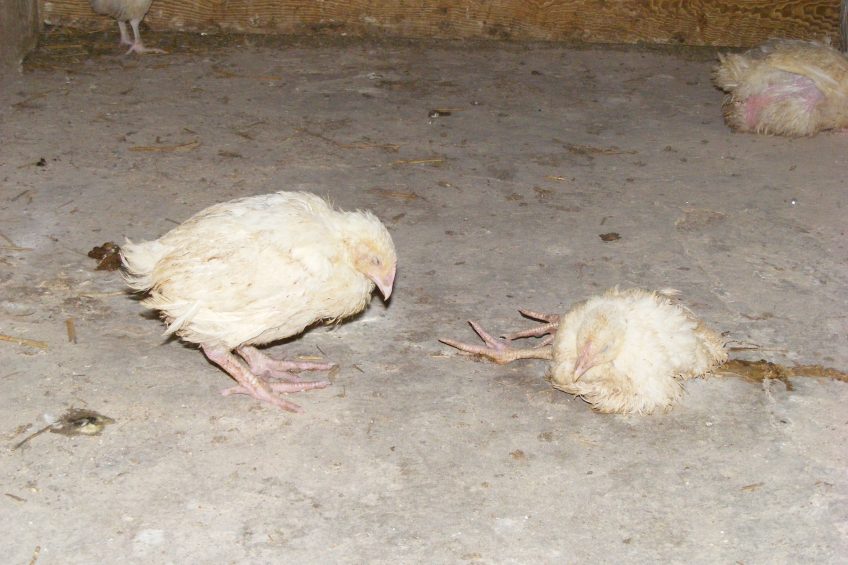Coarse spray vaccination decreases coccidiosis in broilers

Coccidiosis in commercial broiler flocks is still a major cause of financial loss and keeping this to a minimum is essential. A field trial, using an anticoccidial vaccine evaluated the effect of coarse spray vaccination of day old chicks and the results are promising.
By Martina Dardi, M. Pagès and J. Rubio, Hipra Laboratories, Spain*
* Coworkers: M. de Gussem, K. van Mullem and H. van Meirhaeghe, Vetworks, Belgium, N. Vandenbussche, Degudap, Belgium
In industrial poultry production, designing a preventive programme for controlling coccidiosis is one of the most important decisions, in order to safeguard or improve zootechnical and financial results. Traditionally, in-feed anticoccidials had been considered sufficient for controlling clinical coccidiosis. Live coccidiosis vaccines are becoming increasingly popular though, as they often provide a solution when the in-feed anticoccidials become inefficient, because they are able to promote the restoration of the sensitivity of Eimeria field strains towards anticoccidials.
The objective of this study was to evaluate the efficacy of a live coccidiosis vaccine (Hipracox) to prevent clinical coccidiosis in two broiler farms under standard production conditions. Moreover, the zootechnical impact during coccidiosis vaccination and afterwards, when returning to in-feed anticoccidials was evaluated. Both farms were considered by veterinary supervisors as coccidiosis attention farms: signs of coccidiosis were frequently evident through oocyst per gram (OPG) counts, lesion scores or presence of blood in the droppings. The farms were comparable in terms of management, housing, density of birds, feed management and climate. The performance data of approximately 495,000 birds for Farm 1 and of approximately 960,000 birds for Farm 2 were evaluated.
Three major groups
All zootechnical results were divided into three major groups: cycles before vaccination (CBV), cycles during vaccination (CDV) and cycles after vaccination (CAV). The average mortality before vaccination was 3.13%. During vaccination this mortality dropped to 2.67%, which is a 14.7% improvement. After vaccination the mortality rose again to 2.91%, which is still a 7.03% improvement compared to the situation before vaccination. As the houses did not suffer from heavy clinical outbreaks of coccidiosis, it seems difficult to attribute the lower mortality to an improvement in its control. One hypothesis is that an improved control of coccidiosis might improve the general health status of the flock.
Body weight and growth
Since final slaughter ages were different, average live body weights were corrected at the same age (41 days) and are presented per house according to the grouping before, during and after coccidiosis vaccination (Table 1). Before vaccination average body weight was 2,409 grams, whereas after vaccination it was 2,491 grams, an improvement of 82 grams. Feed Conversion Ratio (FCR) was corrected for the weight to result in a FCR2000, which is the FCR corrected to 2000 gram birds. FCR2000 (Table 2) during vaccination had two points of improvement and after vaccination it improved by eight points.
None of the houses in the trial had a higher FCR2000 during vaccination and all of them had an improvement between one and 20 points after vaccination. Data analysis of overall average FCR2000 of CBV, CDV and CAV, found a statistically significant difference (Figure 2). CBV (Table 3) had an average daily growth (ADG) of 58.39 grams, whereas CDV had a lower ADG of 58.04 grams. CAV had an improvement of 2.21 grams resulting in an overall ADG of 60.60 grams.
Estimating flock performance
The European Production Efficiency Factor (EPEF) is a way of estimating the performance of a flock combining the information of mortality, slaughter age, body weight and feed conversion ratio. The results in Table 4 indicate that before vaccination EPEF for all houses was 362, while during vaccination it improved to 370. Finally, after vaccination EPEF improved 37 points up to 399 in comparison to before vaccination.
Compared to cycles before vaccination, antibiotic use was not higher in terms of kg of active product during vaccination on both farms. The main difference between before and during vaccination was the age of the treatments: about one week earlier for the vaccinated cycles and thus, the total amount of antibiotics used is reduced.
Valid economical approach
In order to evaluate the financial implications of vaccination against coccidiosis, the actual data on FCR and final body weight were used (Table 5). As the actual FCR improved six points, live weight improved about 90 grams and mortality was 0.22% less. Feed cost after vaccination for 100,000 birds placed was €477 higher. When calculating the sales value of the meat, a €8,805 higher income was obtained for 100,000 birds. When subtracting expenses from earnings, a net income of 8.33 euro cents per bird placed was obtained for the two farms together.
No statistical differences between pre- and inter-vaccination were found, while absolute results of mortality, FCR2000 and EPEF improved while vaccinating. The post-vaccination situation is very relevant: absolute results for all parameters, except for mortality, are better compared to those of vaccination, while average daily gain, FCR2000 and EPEF are statistically better than before and during vaccination. As a consequence, it seems clear that anticoccidial vaccination promotes the restoration of the sensitivity of Eimeria field strains towards anticoccidials. In conclusion, for the type of farms encountered during the trial, vaccination against coccidiosis with Hipracox proved to be a valid economical approach, both during and especially when returning to in-feed anticoccidials.













